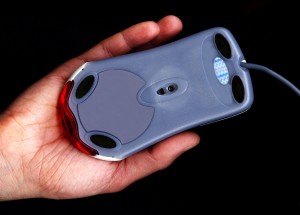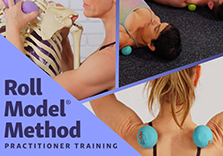
Carpal Tunnel Syndrome may begin as a tingling in the fingers from too much repetitive movement, but left untreated can develop into a serious condition that may even require surgery. Let’s address the situation before it becomes a liability by applying some common sense and a little Yoga Tune Up®!
My Thumb Is Numb
Carpal tunnel syndrome is a swelling of the tissues in the wrist. This swelling can occur for several different reasons, but the end result is that it puts pressure on the median nerve, a major nerve in the hand for both movement and feeling.
When the nerve is impinged in this way, it can cut off both our ability to feel sensation in the hand, and our ability to control the fingers. Initial symptoms may show up as an ache in the wrist that can extend into the hand and up the arm. This can then develop into tingling and numbness in the thumb and middle fingers, and a weakness or tendency to drop things.

However, if the sensation is accompanied by pain or pinching in other areas, it may indicate that the problem is not limited to the wrist but is actually originating deeper in the body. The median nerve is formed from branches of five nerves that originate in the neck and upper back. Because of this, the nerve can be impinged in many different areas (neck, upper back, shoulder, forearm) and all of these will produce similar symptoms in the wrist.
What Brought This On?
Repetitive clasping movements (which flex the tendons in the wrist), rheumatoid arthritis, hormonal imbalances, and even the fluid retention that can happen with pregnancy can all bring on carpal tunnel syndrome. There are no definitive studies to prove this, but many people have developed carpal tunnel syndrome from excessive time spent typing or holding a mouse, or from holding a steering wheel too hard or typing with too much force.
In addition, poor alignment in the neck, or tight muscles in the upper back and neck could also create the same conditions of impingement that would bring on tingling, pain and numbness in the fingers and wrist. If your neck is especially tight, or if you habitually hold a shoulder slightly raised, this can put excessive pressure on the delicate branches of nerves in the neck and upper back.
How Do I Make It Better?
Mild to moderate symptoms can be treated with simple, non-surgical therapies. But if symptoms are persistent and getting worse, you may want to consult a doctor for further options.
Below are three techniques that can be applied immediately for results:
1. Loosen your grip, change the angle and sit up straight! Take a few moments to assess your daily habits and movements, and see what you can do to create optimal alignment in your body. If you grip your steering wheel or mouse tightly, see if you can consciously loosen your grip. If you repetitively strike a keyboard or cash register, try to do it with less force.
Also, pay attention to the angle in your wrist, and the placement of your arms as you perform the repetitive action. Move the keyboard to elbow height to keep the wrists in as neutral a position as possible. Sit with good posture, with the shoulders relaxed and shoulderblades releasing down your back. And take frequent breaks to rest the wrists.
2. Ice and splints If your wrist is swollen, apply a cold pack or ice to reduce the inflammation and take the pressure off the median nerve. You can also wear a wrist splint at night while sleeping to keep the wrist in a neutral position and avoid exacerbating the situation in your sleep.
3. Stretch and strengthen Begin to integrate exercises to stretch and strengthen both the wrists and the upper back and neck, so the body can hold itself in healthy alignment and protect the nerve as it travels through the arm to the wrist.
Carpal Tunnel Syndrome is a common problem, but with a little attention and some simple stretching and strengthening exercises, it doesn’t have to be!
Read our carpal tunnel syndrome article.
Learn about our solutions for hand and wrist pain.
Watch our hand and wrist exercise video on YouTube.











Great article for yoga teachers…things to think about when students talk about wrist pain especially with down dog and planks. I do believe students need to strengthen their wrists but also icing, splinting and loosening the grip is also good advice. Now we need to continue to bring wrist strengthening work into yoga classes.
My wrists have been sensitive lately, thank you for the information. I’ll try your tips to make it better!
This post is such a great reminder to me of what YTU is all about: empowering individuals with knowledge and tools to actually heal themselves. Unlike just putting a splint on it, we can go a step further than damage control and actually build a support system for the injured or compromised parts of our bodies. Practicing YTU is an ongoing commitment with life changing rewards. I have multiple students with carpel tunnel and feel inspired to bring more YTU exercises into my classes to teach my carpel tunnel suffering students “to fish”.
[…] wrist pain exercises Although there are a lot of potential other culprits besides the wrist for Carpal Tunnel Syndrome, sometimes the problem is simple overuse of the hand in a repetitive, tense motion like gripping a […]
Carpal tunnel syndrome is a compression on the the median nerve due to prolong typing, computer gaming and writing. You can check more information on this site and read more articles on our experts advice. http://carpaltunnelhq.com
[…] This left her with repetitive stress injuries in her wrists, which led to the dreaded diagnosis of Carpal Tunnel Syndrome and ensuing surgery. Carpal Tunnel Syndrome implies that the median nerve that runs through the […]
[…] Read more about Carpal Tunnel Syndrome. […]
[…] for some people, are so weak, how you can strengthen them, and could weak wrists be a big cause for carpal tunnel syndrome and not so much just repetitive movements of the hands and fingers. The misalignment of the […]
[…] exercises, carpal tunnel relief, Carpal Tunnel Syndrome, hands, wrists Sprains, fractures, carpal tunnel…wrists seem to get all the attention when it comes to any pain near the hand. And let’s […]
[…] Tune Up® Blog « Carpal Tunnel Syndrome: Why Can’t I Feel My Fingers? Heal Your Aching Hands & Wrists […]
Sarah, thanks for this great article! My mother just recently has been having slight thumb numbness, swelling, and lack of mobility. I am going to pass this along to her so she can try to do some simple stretching and re-aligining. Of course this may or may not be hte answer to her problems but I feel there is no harm. I love how thorough your article is. Thanks!
I actually took your advice to my Dad because he has been having numbness in his forefinger and thumb. He is now grasping the mouse less, watching his posture and working on strengthening his wrists. Thank you for the interesting post.
I enjoyed reading about the exercises for carpal tunnel, as I have suffered for years. I wear splints at night and I find the yoga practice helps on a daily basis!
Yes, carpal tunnel syndrome affects a number of people who work at a computer or do repetitive tasks with their wrists out of neutral alignment. Focusing on posture is number one like you said Sarah. Come on people do better with this! Also people can get a double crush syndrome for nerve compression from either the up town joints such as shoulders and cervical spine. Posture can positively affect this as well as therapy balls and YTU Poses such as shoulder flossing.
Great advice, especially on loosening the grip. I notice in my own work how I tend to hold on to my “tools of the trade,” creating tension in the (extremely) vain hope that by beating my mouse or keyboard into submission that I can retain or regain control of a project, of a client, of the tone of my day. It’s been a long time since I’ve needed to sleep in my wrist braces (thank goodness), but I keep them by my bed (in an attractive basket, hidden under a beautiful silk eye pillow), so that if I’m having a tough time, I have them in easy reach. I also keep soft circular wrist “ice packs” that are covered in velvet in my freezer for a lovely treat when my forearms and wrists are aggravated.
This is great information. Thanks for explaining this in a simple way, giving practical solutions. When I begin teaching, this is exactly the type of information my students will benefit from!
I’ve noticed times when I have caused swelling in a finger joint from too much use. It wasn’t carpal tunnel, but it was still a burden. Now I have some preventative tips. THANKS!
(Keeping this one in my pocket)!
Great article – this is a condition that effects far to many of my clients and fellow bodyworkers. I am glad you made a note to distinguish where the pain is really coming from. It’s better to be aware of the situation and correct it before running to the doctors who will most likely give you something for the pain or refer to a surgeon. I am by no means knocking doctors, they are just working within their scope of practice. On a much larger note – has anyone ever noticed their is no such thing as a “muscle doctor.” We as bodyworkers have the ability to be a great body of knowledge for our clients and to help relieve their musculo-skeletal pain, and this article is a great example of that.
Great idea Ko! I think you’re onto something!
Great suggestions! I would imagine that most problems arise from overuse or misalignment issues. These are great yoga first aid for the body. Jad makes a great point. I would like to see a screen save type program running in the back ground that pops up every now and then to remind the computer user to simply get up and move around. Stretch, give the muscles working those phalanges, metacarpals, carpals, ulna and radius a rest!. Perhaps have a pop up window with some YogaTuneUp suggestions: “bing!! time to supinate those hands!”. What do you think Jill? 😉
With the recent proliferation of laptops, netbooks, and tablets there will likely be an increase in the number of carpal tunnel syndrome complaints because of the lack of ergonomics in these devices. It would be a welcome surprise if one of the manufacturers can make a device that occasionally reminds the user to supinate the wrists, laterally flex the spine, and just stand up to extend the hips so that we can avoid the habits that lead to CTS.
great explanation of what carpal tunnel really is…I hear it all the time, but I didn’t know that it was the swelling of tissues. Just thought it was pressure on your wrist.
great article
There are also ergonomic keyboards, mouses (mice?), and chairs.